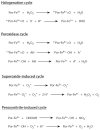The Dual Role of Myeloperoxidase in Immune Response
- PMID: 33137905
- PMCID: PMC7663354
- DOI: 10.3390/ijms21218057
The Dual Role of Myeloperoxidase in Immune Response
Abstract
The heme protein myeloperoxidase (MPO) is a major constituent of neutrophils. As a key mediator of the innate immune system, neutrophils are rapidly recruited to inflammatory sites, where they recognize, phagocytose, and inactivate foreign microorganisms. In the newly formed phagosomes, MPO is involved in the creation and maintenance of an alkaline milieu, which is optimal in combatting microbes. Myeloperoxidase is also a key component in neutrophil extracellular traps. These helpful properties are contrasted by the release of MPO and other neutrophil constituents from necrotic cells or as a result of frustrated phagocytosis. Although MPO is inactivated by the plasma protein ceruloplasmin, it can interact with negatively charged components of serum and the extracellular matrix. In cardiovascular diseases and many other disease scenarios, active MPO and MPO-modified targets are present in atherosclerotic lesions and other disease-specific locations. This implies an involvement of neutrophils, MPO, and other neutrophil products in pathogenesis mechanisms. This review critically reflects on the beneficial and harmful functions of MPO against the background of immune response.
Keywords: cardiovascular diseases; chronic inflammation; immune response; myeloperoxidase; neutrophils; phagosomes.
Conflict of interest statement
The author declares no conflict of interests.
Figures


Similar articles
-
The other myeloperoxidase: Emerging functions.Arch Biochem Biophys. 2018 Jul 1;649:1-14. doi: 10.1016/j.abb.2018.03.037. Epub 2018 Mar 31. Arch Biochem Biophys. 2018. PMID: 29614255 Review.
-
Myeloperoxidase: a front-line defender against phagocytosed microorganisms.J Leukoc Biol. 2013 Feb;93(2):185-98. doi: 10.1189/jlb.0712349. Epub 2012 Oct 11. J Leukoc Biol. 2013. PMID: 23066164 Free PMC article. Review.
-
Neutrophil myeloperoxidase: soldier and statesman.Arch Immunol Ther Exp (Warsz). 2012 Feb;60(1):43-54. doi: 10.1007/s00005-011-0156-8. Epub 2011 Dec 6. Arch Immunol Ther Exp (Warsz). 2012. PMID: 22143159 Review.
-
Human myeloperoxidase in innate and acquired immunity.Arch Biochem Biophys. 2010 Aug 1;500(1):92-106. doi: 10.1016/j.abb.2010.04.008. Epub 2010 Apr 22. Arch Biochem Biophys. 2010. PMID: 20399194 Review.
-
Myeloperoxidase: Its role for host defense, inflammation, and neutrophil function.Arch Biochem Biophys. 2018 Feb 15;640:47-52. doi: 10.1016/j.abb.2018.01.004. Epub 2018 Jan 11. Arch Biochem Biophys. 2018. PMID: 29336940 Review.
Cited by
-
Micrococcal Nuclease stimulates Staphylococcus aureus Biofilm Formation in a Murine Implant Infection Model.Front Cell Infect Microbiol. 2022 Jan 17;11:799845. doi: 10.3389/fcimb.2021.799845. eCollection 2021. Front Cell Infect Microbiol. 2022. PMID: 35111695 Free PMC article.
-
Effect of Bacterial Nanocellulose with Chemisorbed Antiseptics on Alveolar Bone Repair in Rats Undergoing Bisphosphonate Therapy.Pharmaceutics. 2024 Dec 26;17(1):24. doi: 10.3390/pharmaceutics17010024. Pharmaceutics. 2024. PMID: 39861673 Free PMC article.
-
The role of neutrophils in allergic disease.Clin Exp Immunol. 2025 Jan 21;219(1):uxae126. doi: 10.1093/cei/uxae126. Clin Exp Immunol. 2025. PMID: 39721985 Free PMC article. Review.
-
Role of Myeloperoxidase, Oxidative Stress, and Inflammation in Bronchopulmonary Dysplasia.Antioxidants (Basel). 2024 Jul 23;13(8):889. doi: 10.3390/antiox13080889. Antioxidants (Basel). 2024. PMID: 39199135 Free PMC article. Review.
-
Myeloperoxidase as a Marker to Differentiate Mouse Monocyte/Macrophage Subsets.Int J Mol Sci. 2022 Jul 26;23(15):8246. doi: 10.3390/ijms23158246. Int J Mol Sci. 2022. PMID: 35897821 Free PMC article.
References
-
- Arnhold J. Cell and Tissue Destruction. Mechanisms, Protection, Disorders. Academic Press; London, UK: San Diego, CA, USA: Cambridge, MA, USA: Oxford, UK: 2020. Immune response and tissue damage; pp. 155–204.
-
- Arnhold J. Cell and Tissue Destruction. mechanisms, Protection, Disorders. Academic Press; London, UK: San Diego, CA, USA: Cambridge, MA, USA: Oxford, UK: 2020. Acute-phase proteins and additional protective systems; pp. 205–228.
-
- Allen R.C., Stevens D.L. The circulating phagocyte reflects the in vivo state of immune response. Curr. Opin. Infect. Dis. 2006;5:389–398. doi: 10.1097/00001432-199206000-00013. - DOI
Publication types
MeSH terms
Substances
LinkOut - more resources
Full Text Sources
Research Materials
Miscellaneous

